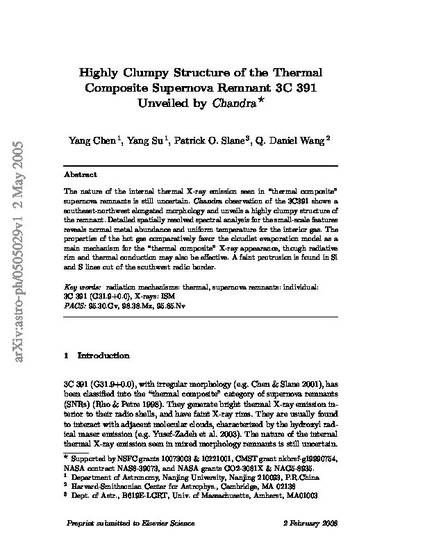
Article
Highly clumpy structure of the thermal composite supernova remnant 3C 391 unveiled by Chandra
Advances in Space Research
Publication Date
2005
Abstract
The nature of the internal thermal X-ray emission seen in “thermal composite” supernova remnants is still uncertain. Chandra observation of the 3C391 shows a southeast–northwest elongated morphology and unveils a highly clumpy structure of the remnant. Detailed spatially resolved spectral analysis for the small-scale features reveals normal metal abundance and uniform temperature for the interior gas. The properties of the hot gas comparatively favor the cloudlet evaporation model as a main mechanism for the “thermal composite” X-ray appearance, though radiative rim and thermal conduction may also be effective. A faint protrusion is found in Si and S lines out of the southwest radio border.
Disciplines
DOI
https://doi.org/10.1016/j.asr.2005.01.005
Pages
1007-1011
Citation Information
Y Chen, Y Su, PO Slane and QD Wang. "Highly clumpy structure of the thermal composite supernova remnant 3C 391 unveiled by Chandra" Advances in Space Research Vol. 35 Iss. 6 (2005) Available at: http://works.bepress.com/daniel_wang/26/

This is the pre-published version harvested from ArXiv. The published version is located at http://www.sciencedirect.com/science?_ob=ArticleURL&_udi=B6V3S-4FD79HW-K&_user=1516330&_coverDate=12%2F31%2F2005&_rdoc=1&_fmt=high&_orig=gateway&_origin=gateway&_sort=d&_docanchor=&view=c&_acct=C000053443&_version=1&_urlVersion=0&_userid=1516330&md5=0ad53aba0aa8032f755b7c12f8b88631&searchtype=a